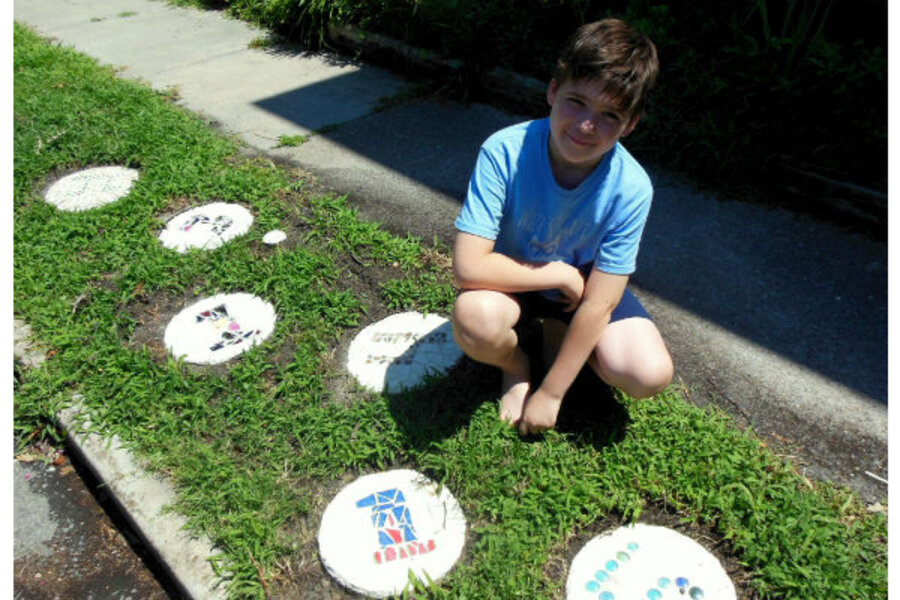Crowdfunding kids: How to kickstart creativity and planning
Loading...
Crowdfunding has become a popular way for adults and kids to kickstart dreams in areas ranging from the arts to technology. It’s also a great way for parents to help their children realize some small dreams while teaching them about how to define and communicate their goals to others.
Our youngest son Quin, 10, who loves both math and art, was bored to tears when most of his friends packed off to summer camps we couldn’t afford.
That left me to run Camp Mom and him to think about STEAM (Science Technology Engineering Art and Math) projects he might like to tackle while his friends are away.
I have been making mosaics with him and doing other art and craft projects that incorporate geometry, patterns, calculations, and creativity.
When a neighbor saw all the things we were making for our yard, she gave us plain old, round, concrete stepping stones to try and transform. I suggested that we try making mosaics of numbers to make a hopscotch board in the grass along the side of our home.
"If we’re doing something with numbers, we should do Pi instead,” Quin said. “I think we should try and challenge ourselves to make as many of the numbers in the sequence as we can possibly make."
That would be great, but Pi is an irrational number derived from the equation for the ratio of a circle's circumference to its diameter. So therefore, the digits of Pi are infinite.
Making mosaics requires mortar, grout, and tile or smashed up ceramics and glass. We had enough resources to afford to make only the first six digits of Pi – 3.14159.
“That’s what I call Puny Pi,” said Quin grumpily. “I could raise money like my friends did.”
After seeing two of his friends go door-to-door asking for money to “fund our dreams” I decided to give Quin a safer way to make his goal by starting his own Kickstarter campaign.
We went through the steps of setting up an account together under my name. Kickstarter allows kids to do campaigns as long as the account is set up in the parent’s name with an adult’s banking information, according to Kickstarter Communications representative Justin Kazmark.
Setting up the campaign on Kickstarter was a great exercise for Quin because it entailed writing a short bio and mission statement, and clearly outlining his goal. He also had to speak on camera to make a video, which meant verbally communicating his goals.
We even did a little research by looking at campaigns by other kids and adults to see if we could detect a pattern that led to success.
Quin suggested that in order for his campaign to succeed he would take what he called “The potato salad guy approach.” He was referring to Zach Danger Brown of Columbus, Ohio, an adult who asked for $10 to make potato salad and so far has raised $51,967 with seven days left to go.
“Potato salad’s interesting,” Quin said after reading about the potato salad project. “But Pi is infinitely better. Get it, because Pi is an infinite number and sounds like a food? Potatoes. Pi.”
Instead of getting lost in puns, I explored how to set up a campaign.
Each step he had to take to create his campaign was a building block.
He had to define and convey his goals succinctly. He also had to come up with what materials he would need and determine their costs. Finally, he had to come up with how to incentivize his backers.
“I can put their names on the Pi stones like they did with names on bricks when they raised money for the school,” Quin said. “I can make a special one (Pi stone) and send it to the bigger backers.”
To decide on a monetary goal we looked at other campaigns by kids.
We looked at “Cattle for Kids,” a project started by rural South Carolina farm kids trying to start our own beef cattle herd, in order to provide livestock to kids in poverty. Their goal is $20,000 and with 14 days to go, they have only raised $1,382.
This bolstered the ask for less, potato salad approach.
Another campaign that supported this theory was started by Carter, 9, a Jacksonville, Fla. “Kid animal expert” who wants to share his knowledge via videos that educate others about animal conservation and environmental preservation.
Carter needs $1,700 and has raised only $77 with 15 days to go.
Seeing these other campaigns and many more, Quin concluded that he needed to think small to win big. His goal was $50
He launched his project at 4:03 p.m. Thursday and woke Friday morning to find he had raised $90.
“This tells me two things,” he said. “There are a lot of people who love math as much as I do. Be humble and ask for less and people will help you more.”
Asked what he will do if he continues to get backers over the next 29 days Quin said, “A guy wrote me a comment that I inspired him to do the same project in his neighborhood. So if I get more than I need I’m gonna help other people make Pi.”
Overall, I’d say the parental campaign to keep a child thinking and busy all summer by incorporating art, math, and crowdfunding is a good goal worth chasing.








